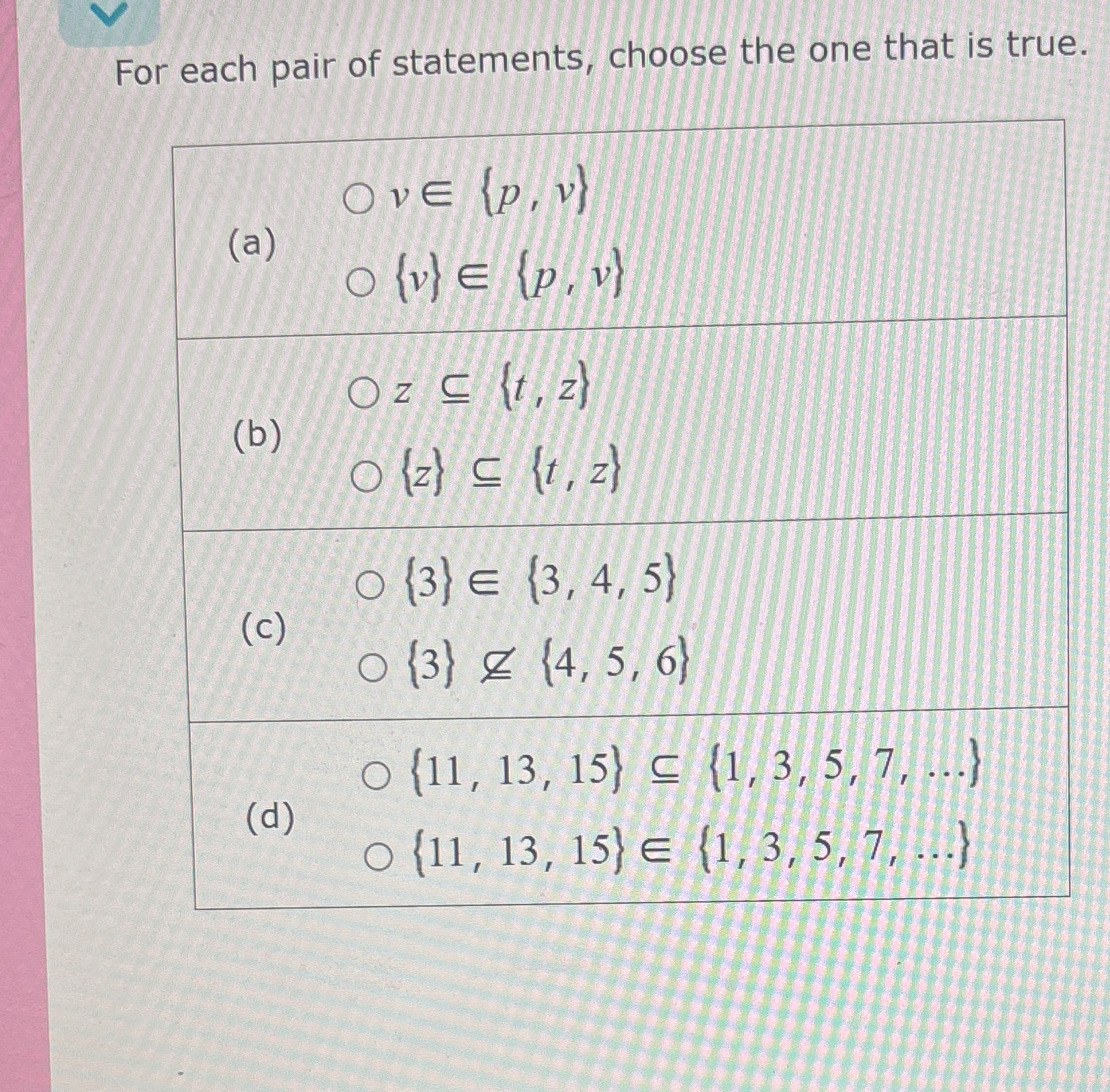For each pair of statements, choose the one that is true: (a) v ∈ {p, v} or {v} ∈ {p, v} (b) z ⊆ {t, z} or {z} ⊆ {t, z} (c) {3} ∈ {3, 4, 5} or {3} ∉ {4, 5, 6} (d) {11, 13, 15} ⊆ {1... For each pair of statements, choose the one that is true: (a) v ∈ {p, v} or {v} ∈ {p, v} (b) z ⊆ {t, z} or {z} ⊆ {t, z} (c) {3} ∈ {3, 4, 5} or {3} ∉ {4, 5, 6} (d) {11, 13, 15} ⊆ {1, 3, 5, 7, ...} or {11, 13, 15} ∈ {1, 3, 5, 7, ...}

Understand the Problem
The question presents four pairs of set theory statements (a, b, c, d), each involving set membership (∈), subset (⊆), or non-membership (∉) relations. The task is to identify the true statement within each pair. The high-level approach involves understanding the definitions of set membership and subset, and then carefully evaluating each statement based on those definitions.
Answer
(a) $v \in \{p, v\}$ (b) $\{z\} \subseteq \{t, z\}$ (c) $\{3\} \notin \{4, 5, 6\}$ (d) $\{11, 13, 15\} \subseteq \{1, 3, 5, 7, ...\}$
Answer for screen readers
(a) $v \in {p, v}$ (b) ${z} \subseteq {t, z}$ (c) ${3} \notin {4, 5, 6}$ (d) ${11, 13, 15} \subseteq {1, 3, 5, 7, ...}$
Steps to Solve
- Evaluating statement (a)
- $v \in {p, v}$: This statement means "v is an element of the set containing p and v." This is true because $v$ is indeed listed as one of the elements in the set ${p, v}$.
- ${v} \in {p, v}$: This statement means "the set containing only v is an element of the set containing p and v." This is false because the elements of the set ${p, v}$ are $p$ and $v$, not the set ${v}$.
- Evaluating statement (b)
- $z \subseteq {t, z}$: This statement means "the set containing z is a subset of the set containing t and z". The set containing z is ${z}$. For ${z}$ to be a subset of ${t, z}$, every element in ${z}$ must also be in ${t, z}$. Since $z$ is in ${t, z}$, the statement ${z} \subseteq {t, z}$ is true. Note that the problem wrote $z \subseteq {t, z}$ which treats $z$ as if it were a set already, which is incorrect.
- ${z} \subseteq {t, z}$: This statement means "the set containing $z$ is a subset of the set containing $t$ and $z$". This is true, as discussed above.
- Evaluating statement (c)
- ${3} \in {3, 4, 5}$: This statement means "the set containing 3 is an element of the set containing 3, 4, and 5." This is false. The elements of the set ${3, 4, 5}$ are $3$, $4$, and $5$, not the set ${3}$.
- ${3} \notin {4, 5, 6}$: This statement means "the set containing 3 is not an element of the set containing 4, 5, and 6." This is true because the elements of ${4, 5, 6}$ are $4$, $5$, and $6$, and ${3}$ is not among them. Also, $3 \notin {4, 5, 6}$ is true as well.
- Evaluating statement (d)
- ${11, 13, 15} \subseteq {1, 3, 5, 7, ...}$: This statement means "the set containing 11, 13, and 15 is a subset of the set of all positive odd integers." This is true because 11, 13, and 15 are all positive odd integers.
- ${11, 13, 15} \in {1, 3, 5, 7, ...}$: This statement means "the set containing 11, 13, and 15 is an element of the set of all positive odd integers." This is false because the elements of the set ${1, 3, 5, 7, ...}$ are individual odd numbers, not sets of odd numbers.
(a) $v \in {p, v}$ (b) ${z} \subseteq {t, z}$ (c) ${3} \notin {4, 5, 6}$ (d) ${11, 13, 15} \subseteq {1, 3, 5, 7, ...}$
More Information
Set theory is fundamental to mathematics and computer science.
Tips
A common mistake is confusing the concepts of "element of" ($\in$) and "subset of" ($\subseteq$). Remember that $\in$ relates an element to a set, while $\subseteq$ relates a set to another set.
AI-generated content may contain errors. Please verify critical information